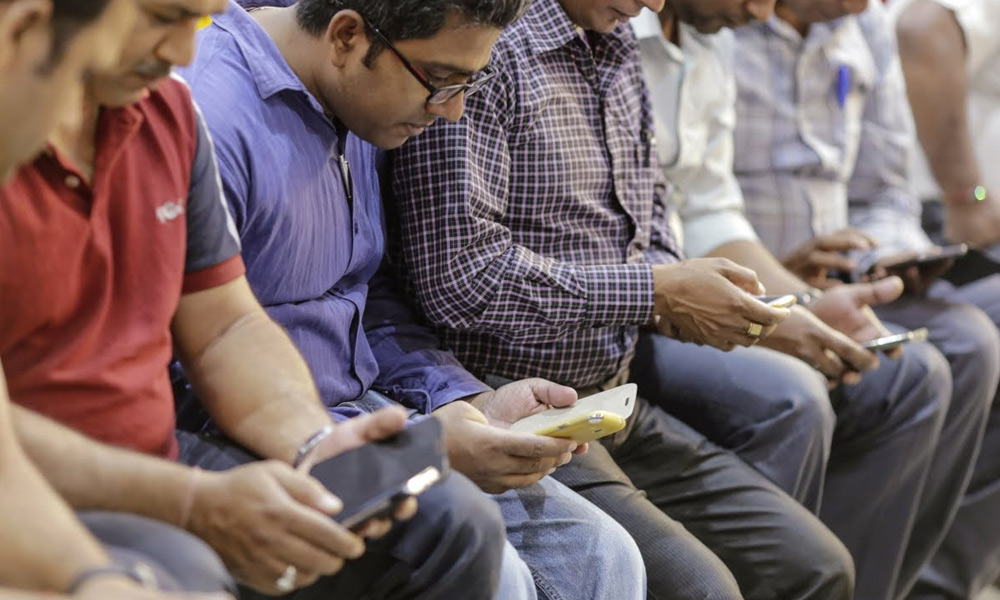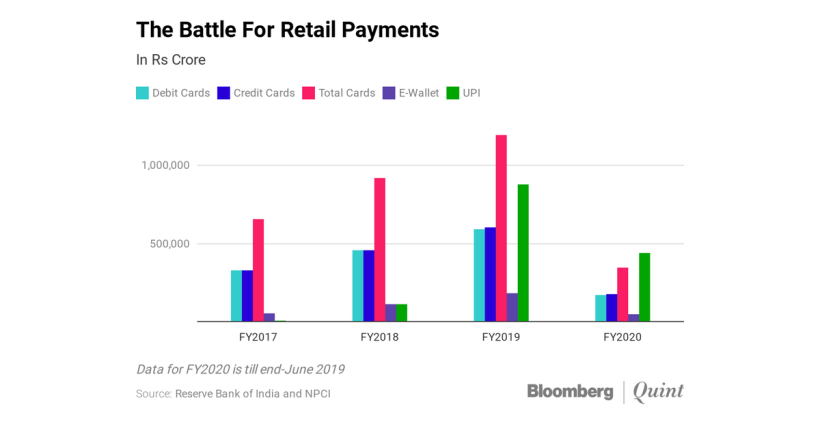UPI Transactions Poised To Overtake Debit, Credit Card Payments This Year

The Unified Payments Interface is challenging the dominion of retail card payments, with the value of UPI-based transactions coming close to equaling those made via credit and debit cards.
Launched by the National Payments Corporation of India in April 2016, transactions on UPI-based platforms added up to Rs 8.7 lakh crore as of March 2019 compared to Rs 1 lakh crore at the end of March 2018, showed data released as part of the Reserve Bank of India's Annual Report for 2018-19. In terms of value, UPI transactions made up 73 percent of all debit and credit card transactions combined in FY19, the data showed.
A year ago, UPI transactions made up just 12 percent of all transactions conducted on debit and credit cards.
Debit and credit cards are used to withdraw cash at ATMs, a feature which UPI does not perform. Therefore, ATM transaction data for cards has been excluded.

Moreover, in the first three months of 2019-20, data from the RBI and NPCI shows UPI transactions have crossed Rs 4.4 lakh crore compared to Rs 3.45 lakh crore worth of card transactions across point-of-sale devices and online channels.

UPI is an inter-operatable, real-time payments mechanism that is based on an open-architecture framework. In essence, this means that any bank or financial services entity can easily integrate UPI into their operations or mobile applications.
Manish Jain, partner, digital and fintech management consulting, at KPMG India said that he does not think that UPI is cannibalizing the market share of payment channels like cards or e-wallets. Instead, the size of the electronic payments industry is growing through the penetration of all these channels.
According to an NPCI official, who spoke on condition of anonymity, there is healthy competition between the two payment methods. Cards, e-wallets and UPI are now being used interchangeably by customers, said the NPCI official quoted above. Even though UPI has made peer-to-peer and peer-to-merchant transactions cheaper, people are still using e-wallets and cards to a large extent, albeit for different reasons.
P2M transactions on UPI a year ago were around 10-15 percent of the total transactions, which means that UPI growth was mainly on the back of P2P transactions, said Deepak Sharma, chief digital officer at Kotak Mahindra Bank Ltd. "UPI is largely replacing cash transactions for buying goods and services and has replaced low-value debit card transactions," Sharma said.
The average transaction size is between Rs 500 to Rs 600, so UPI is being used by customers for high-frequency low-value transactions, while customers use their cards and net-banking for low-frequency high-value transactions, Sharma explained.
UPI's Growth Path
The goal of NPCI is to increase adoption of digital payment platforms beyond Tier-II geographies by easing convenience while ensuring security, the NPCI official quoted said
“We see P2M adoption being the big growth driver going forward especially through the offline QR-code transactions,” Sharma said. At Kotak Mahindra Bank, P2M transactions accounts for 35 to 40 percent of all UPI transactions, he said. The bank expects P2M transactions to cross 50 percent this year.
“UPI has seen a huge growth on our platform but we also have millions of cards saved by customers on our platform who use them on a daily basis,” said Hemant Gala, head of payment, banking and financial services at PhonePe. Gala expects all these payment options to co-exist with the customer choosing the one which provides them least friction and best experience.
To increase penetration of UPI further, the NPCI is focusing on ways to enhance offline UPI payments through the QR-code method. Additionally, the payments organisation is looking at UPI solutions for feature phones to target customers in rural areas, said the NPCI official quoted above.
Going forward the strategy is to find specific use-cases for it, such as use of UPI for retail investing in initial public offerings, the NPCI official pointed out. These use-cases include introducing an e-mandate service and facilities to pay equated monthly installment through UPI. Such additional features are subject to regulatory approvals, the official said.
Click here to subscribe to WhatsApp updates from BloombergQuintStay Updated With Business News News On BloombergQuint
Most Read
- China Scraps Foreign Investment Limit in Stock, Bond Markets
- India-China Spat Delays Deal Covering a Third of Global Trade
- Yes Bank Clarifies On News Reports Regarding Stake Sale
- Nirmala Sitharaman Says India's Auto Slowdown Due To Change In People's Mindset
- Hedge Funds Left Dizzy by Mnuchin's Fannie-Freddie Musings
